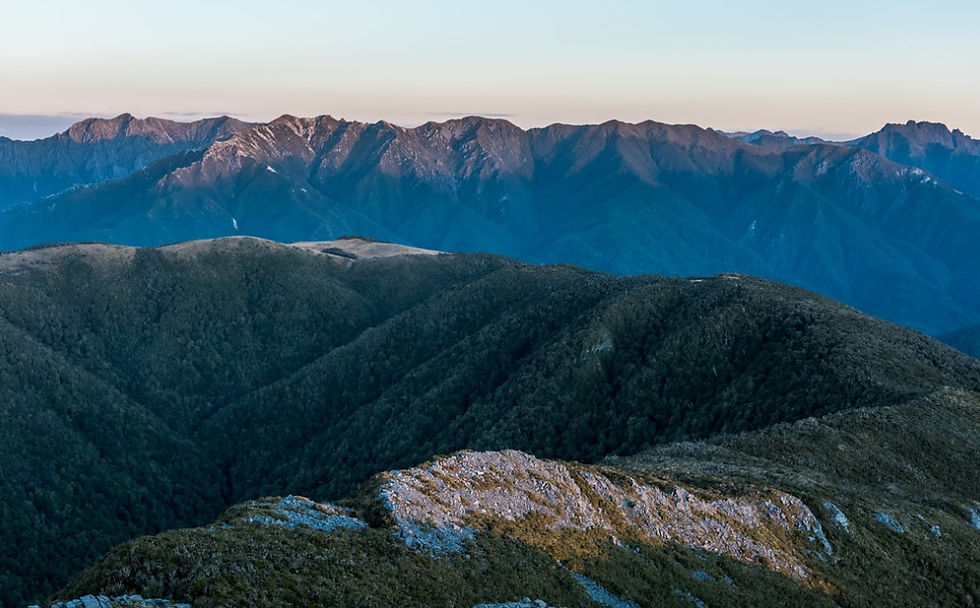Sidestep: The Stone Bowls
- IJ
- Jul 9, 2017
- 3 min read

In the 1930's on the upper slopes of Mt. Olympus, Marlborough (foreground above) there was found a stone bowl measuring ten inches in diameter and five inches in depth (Photo 1) almost buried in the earth. The person that excavated round it and was agreeably surprised to discover that the bowl was placed in a hole in a small rock into which it just fitted. They discoverer was certain that human hands had placed it there, but for what use or purpose they did not know. (Photo 2).
Discussing the matter with an old resident, they were informed me that about forty years previously he had noticed a hole in a rock back on the Lansdowne hills. Following his directions, the person had no difficulty in locating on a spur leading on to the main range, a small rock with a hole in it, and on one side of the rock had been placed a half-circle of broken pieces of rock. Here again was evidence of the work of man; human hands had definitely placed those pieces of rock in position (Photo 3).
On the now grass-covered slopes on the southern side of the Wairau Valley were two rocks with holes in them and in one was a stone bowl. What had they been used for by the Maori? Were they even Maori?
My explanation of their ancient use is that the rocks are what Williams terms waituhi, meaning a rock with a hole in it in which water collected or was placed in a dry season, and around which bird snares were set. The stone bowl would be more specifically a waka waituhi, or a vessel used for the same purpose. Such was one of the Maori methods of taking the pigeon.
At some remote period, long before the coming of Europeans, the upper reaches of the now arid Wairau Valley where these relics were found, was clothed in forest. Indisputable evidence of this is found in swamps where logs are encountered during draining operations, and on the hills there may still be seen the last remains of totara logs, many of them almost buried in the earth, evidence that a forest once flourished here and the forest meant bird life.
The height of Mt. Olympus is 3,097 feet above sea-level and where I found the stone bowl would be about 2,000 feet. The rock on the Lansdowne hills is on a somewhat lower level, and approximately four miles from the former locality. I have knowledge of a number of places showing evidence of ancient occupation about this locality and doubtless there are others which may be found in the future.
Stone Bowl from Waituhi An example of an enlarged natural hollow Excavated Rock in which bowl fitted sat
at Waituhi, Landsdowne hills at Waituhi, Mt Olympus
So, from the above we can see that there was a forested area in which an unusually laborious method of carving pigeon traps was made. Of course, if you consider the effort required compared to carving a wooden bowl for the same purpose, it is clear the bowl and hollow in which it sat was more likely to be of ceremonial or religious use.
This area is close by where the first Polynesian immigrants eked out an life of hardship, separate to those of the small numbers of existing inhabitants of Aotearoa (that name meaning only the South Island at that time). This area is also close to where some of the most unusual artefacts have been found at D'Urville Island.
*****
Below is a stone carved bowl found near Tauranga that was buried 1.5 metres under fern country when someone began to dig for a post hole. There was a thriving culture here long before the Polynesians arrived, as evidenced by the photo below and more certainly due to the fact this bowl does not appear in any museum record. The last known person to hold this item was T. Chamberlain of Khandallah Wellington. Investigation of his relatives may yet have it turn up?

Archaic carved stone bowl
The carved stone bowl figured in the plate was dug up in the 'nineties. It was found in digging a hole for a strainer, at a depth stated by the Maori finder to be five feet below the surface, in fern land on a slope of Maungatawa, near Tauranga. The bowl is now in the possession of T. Chamberlin Chamberlin, of Khandallah, Wellington






















































Comments